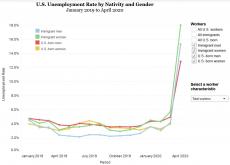Immigrant and Other U.S. Workers a Year into the Pandemic: A Focus on Top Immigrant States
More than a year since the onset of the COVID-19 pandemic, and six months into U.S. vaccination efforts, the economy is starting to rebound from the worst of the economic recession induced by stay-at-home mandates, social-distancing measures, supply chain disruptions, and other pandemic impacts. Employment levels are also recovering, though the picture is different across states and industries.
Nationwide, since the recession began, foreign-born workers have had higher unemployment rates than native-born workers, due partly to their higher concentrations in industries and occupations in which layoffs were more widespread. And while immigrants’ employment levels have recovered more quickly than those of their U.S.-born counterparts, as of the first quarter of 2021, the share of U.S.-born workers in jobs was closer to pre-pandemic levels than was the case for immigrants.
This issue brief examines how immigrant workers’ employment experiences during the recession have varied based on their state of residence, industry of employment, gender, and other factors. The brief explores data on U.S.- and foreign-born workers’ employment trends in the ten states with the largest immigrant populations and in three key industries: health care, construction, and leisure and hospitality. It also considers contextual factors for these trends, including states’ differing mix of industries, timing and length of stay-at-home orders, definitions of essential workers, stringency of restrictions on restaurants and bars, and timing and intensity of COVID-19 outbreaks.
1 Introduction
2 Comparing Overall U.S.- and Foreign-Born Employment Rates
3 Differences in Immigrant and U.S.-Born Employment Rates by Gender
4 Unemployment Outcomes by Industry and State
A. Top Industries of Employment for Immigrant Workers by State
B. Overall Unemployment Trends among Immigrant Workers
C. Unemployment in the Health-Care Industry
D. Unemployment in the Construction Industry
E. Unemployment in the Leisure and Hospitality Industry
5 Conclusion



